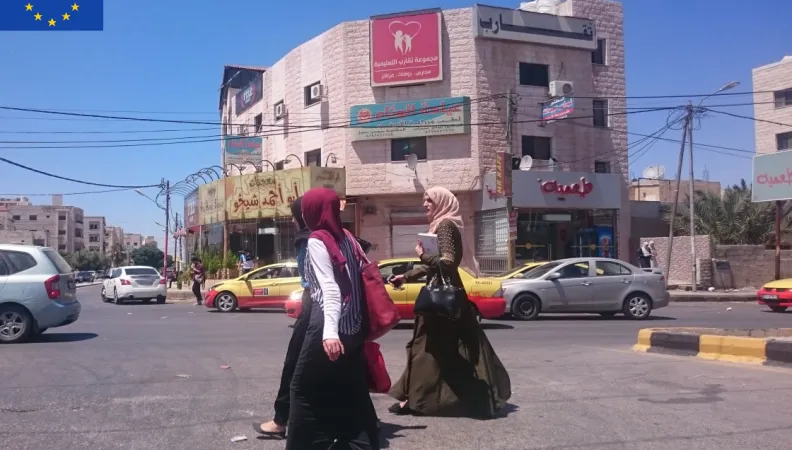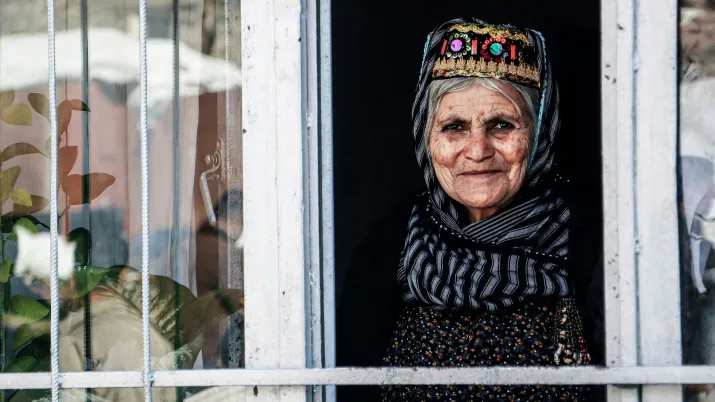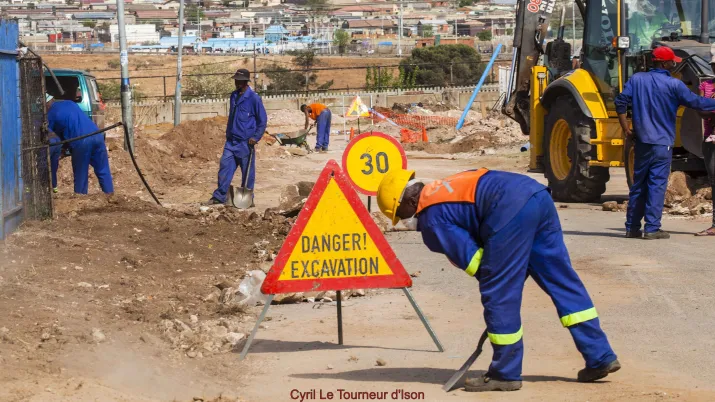Amman, Jordanie
Amman
Jordanie
 What is the short-term impact of the COVID-19 pandemic on households and firms behaviour in the Middle East and North Africa? A research partnership between AFD and the Economic Research Forum (ERF) provides evidence on the short-term effects and responses in Tunisia, Sudan, Morocco, Jordan, Egypt and Algeria.
What is the short-term impact of the COVID-19 pandemic on households and firms behaviour in the Middle East and North Africa? A research partnership between AFD and the Economic Research Forum (ERF) provides evidence on the short-term effects and responses in Tunisia, Sudan, Morocco, Jordan, Egypt and Algeria.
Contexte
Since 2020, the COVID-19 pandemic has been testing the employment stability, the production capacity, the food availability as well as social protection systems response capacity in the Middle East and North Africa (MENA) region at an unprecedented scale. Thus, evidence is needed to detail how are countries faring in the short-run of this global event and how are governments responding to alleviate the vulnerabilities faced by household and firms alike.
Objectif
ERF and AFD have collaborated in a research partnership aimed to provide a platform to answer some pressing questions regarding the impact of COVID-19 on people’s lives and firms’ behaviours, and shed light on the coping mechanisms that have been taken to help them in these tough times. This project was led by Ragui Assaad (University of Minnesota and ERF), Caroline Krafft (St. Catherine University), and Mohamed Ali Marouani (Université Paris1-Panthéon-Sorbonne and ERF).
Under this collaboration, a call for proposals was launched in 2020 on “The Impact of COVID-19 on Households and Firms in the MENA Region”, with a view to understand the consequences of the social and economic crisis generated by the pandemic. ERF received 53 proposals, and the review process led to the acceptance of 6 proposals selected to use some novel rapid phone surveys for household and firms, to highlight with relevant research questions several dimensions of coping mechanisms and changes experienced in several countries of the MENA region. Six articles and six policy briefs are part of this collaboration.
Method
Researchers responding to this call received access to the data of the new ERF COVID-19 MENA Monitor rapid phone surveys, including enterprise survey data (available for download) and household survey data (available for download) for the following countries: Egypt, Morocco, Tunisia and Sudan.
As part of the partnership, four ERF policy briefs describe the data and provide a digest of what the rapid phone surveys describe about the impact of the pandemic on MENA labour markets and firms:
- Krafft, Assad & Marouani (2022), The Impact of COVID-19 on Middle Eastern and North African Labor Markets: Employment Recovering, but Income Losses Persisting
- Krafft, Assad & Marouani (2021c), The Impact of COVID-19 on Middle Eastern and North African Labor Markets: A Focus on Micro, Small and Medium Enterprises
- Krafft, Assad & Marouani (2021b), The Impact of COVID-19 on Middle Eastern and North African Labor Markets: Glimmers of Progress but Persistent Problems for Vulnerable Workers a Year into the Pandemic
- Krafft, Assad & Marouani (2021a), The Impact of COVID-19 on Middle Eastern and North African Labor Markets: Vulnerable Workers, Small Entrepreneurs, and Farmers Bear the Brunt of the Pandemic in Morocco and Tunisia
Results
The six selected research projects provide a wide variety of evidence in the context of research on the short-term socio-economic effects of the Covid-19 pandemic:
- The first article (by V. Hlasny & S. Al Azzawi) explores the effects of the pandemic on workers’ employment outcomes in Egypt and Jordan. They estimate logit models of workers’ job loss and multinomial logits of workers’ labour market statuses, investigating who has been most affected among the working population. They show the COVID regime stringency having affected negatively employment and labour market participation of most groups of workers – particularly youths, even if they were not disadvantaged pre-COVID. Higher education is associated with the retention of a better employment status, conferring consistently high returns in terms of remaining an economically active individual, or remaining employed, and in formal employment. Workers’ pre-COVID employment status affects their outcomes amid COVID, implying strong employment-status dependence. Those laid off amid COVID come predominantly from among those without (formal) employment pre-pandemic. Between mid-2020 and mid-2021, men’s employment prospects gradually improved, but women faced a stagnation, by being largely excluded from work opportunities. Youths trailed non-youths early during the pandemic, but have caught up during recovery. In sum, youths and women have been affected more adversely than non-youths and men at the height of the pandemic. They face higher risks of getting laid off, and have a harder time returning to work – supporting the ‘last in’ if not the ‘first out’ hypothesis.
- The second article (by Z. El-Sahli & M. Alsamara) investigates the effects of the pandemic on small and medium-sized enterprises (SMEs) in four non-oil-exporting MENA countries (Jordan, Morocco, Tunisia, and Egypt). MENA SMEs resorted to wage and work hours reductions more often than layoffs in the wake of the pandemic. Within SMEs, larger firms are more resilient, recover faster, and adapt more often. At the sectoral level, the accommodation and food services sector is the worst affected in most of its outcomes. There is, however, clear recovery in Q2 2021 (versus Q1) across sectors and countries. Furthermore, SMEs that switch to remote work are less likely to face closures, they recover faster, and adapt more frequently, signalling higher resilience and adaptability. On the other hand, participation in government assistance programs does not improve firm outcomes, whereas firms that participate in international trade are more resilient and adaptable in the face of the shock.
- The third article (by A. El-Shal, E. Moustafa, N. Rostom & Y. Abdelfattah) looks at social safety nets (SSNs) and emergency transfers from NGOs during the onset of the pandemic, estimating if and to what extent SSNs have mitigated food insecurity in MENA between November 2020–June 2021 in Egypt, Morocco, Jordan and Tunisia. Using a difference-in-differences approach, the authors show that those who received non-usual government support in Tunisia were 15 percentage points (ppts) less likely to be unable to buy their typical amount of food due to price increases than those who did not receive support. No significant effects are observed in Egypt, Jordan, and Morocco. Non-usual social support from non-governmental institutions had greater effect. Individuals who received non-usual support from non-governmental institutions in Morocco and Jordan were, respectively, 22 ppts and 15 ppts less likely to report being unable to buy their typical amount of food due to decreased income. Their estimates also show that government SSNs have mitigated the negative effect of food insecurity on resorting to adverse coping strategies during COVID-19, especially selling assets
- The fourth article (by A. Spinardi, N. Isamiddinova, I. Clavijo & K. Henkens) investigates the associations between factors affecting households during the pandemic, such as food insecurity and gender mental health inequalities in Egypt, Tunisia, Morocco, Jordan, and Sudan. Using data from the World Health Organization (five-question module to measure mental health and well-being) and the ERF COVID-MENA Monitor Household Survey, it inspects gender mental health gap and quantifies the relative contributions of some COVID-19 related shocks and changes on gendered mental health inequality. The results indicate a statistically significant difference in the mental health well-being between men and women, with women’s mental health being significantly poorer than that of men. Women, on average, worry more over the health consequences of the pandemic and the household’s economic situation. They report higher levels of food insecurity in their households, and this variable significantly explains the observed difference in mental health outcomes between genders.
- The fifth article (by L. Idres & M. Lassassi) analyses the populations’ behaviour toward COVID-19 safety measures in Algeria, Morocco and Tunisia, specifically inspecting which safety measures are observed and what category of people is most likely to observe them. To answer these questions, ERF COVID-MENA Monitor Household Survey are used for Morocco and Tunisia, whilst for Algeria a household survey collected from the Research Center of Applied Economics for Development (CREAD) is used. There are some similarities among the population’s behaviour of these countries, such as the fact that women are found to be those who most observe the safety measures. The educational level also plays a role in determining behaviour, but its impact differs from country to country. Moreover, an ordered probit model is estimated to identify the determinants of the observed safety measures intensity in each country. Women and the elderly mostly comply with the barrier methods, but men and youth are those who use these measures more intensely. Furthermore, a simulation analysis shows that the percentage of Moroccans observing three safety measures converges to 80%, against 59% in Tunisia, and only 5% in Algeria.
- The sixth article (by S. Nour) proposes a country case study for Sudan, using two distinct sources of data. The World Bank and Sudan Central Bureau of Statistics High Frequency COVID-19 Survey (2020) data shows that the impact of COVID-19 on employment status is manifested in a loss of jobs for the majority and nearly two-thirds of households during June - July 2020. The employment loss, the unemployment and even the change of employment of households are mainly explained by the closure of businesses and administrations due to the restrictions applied in response to the pandemic. The impact of COVID-19 is also manifested in loss of income for almost a fifth of households, and reduction of livelihoods or sources of income. The ERF COVID-19 MENA Monitor Household Survey (2021) shows an increase in temporary or permanent layoffs/suspensions of workers, reduced hours, reduced wages, delays in payment of wages for workers and a limited provision of social insurance to workers.
Lessons learned
Several recommendations stem from the research questions discussed within this research partnership. These are available for free download from the AFD Policy Dialogue series:
- “Women and Youth labor market outcomes during Covid19: Evidence from Egypt and Jordan”
- “Resilience in the Time of Covid-19: Lessons Learned from MENA SMEs”
- “Social Safety Nets and Food Insecurity in MENA in the Time of Covid-19”
- “Gender and Mental Health: Covid-19 shock-related factors”
- “Populations' behavior analysis toward Covid-19 safety measures: Evidence from Algeria, Morocco and Tunisia”
Contact:
- Cecilia Poggi, AFD Research Officer
- Yasmine Fahim, Director of Research & Programs, ERF
 Legal notice EU (project) This study analyzes trends in inequalities between 2010 and 2016 in the two main Jordanian cities hosting Syrian refugees: 194,000 Syrians in Amman and 140,000 in Irbid, according to 2018 data of the United Nations Refugee Agency (UNHCR). This research project involves studying the impact of the influx of Syrians on trends in economic inequalities (incomes, growth, poverty, etc.) and on the housing market (real estate market, share of housing in household expenditures, etc.).
Legal notice EU (project) This study analyzes trends in inequalities between 2010 and 2016 in the two main Jordanian cities hosting Syrian refugees: 194,000 Syrians in Amman and 140,000 in Irbid, according to 2018 data of the United Nations Refugee Agency (UNHCR). This research project involves studying the impact of the influx of Syrians on trends in economic inequalities (incomes, growth, poverty, etc.) and on the housing market (real estate market, share of housing in household expenditures, etc.).
Context
According to the official Jordanian population census, there were an estimated 1.2 million Syrian refugees in the country as of November 2015. This figure corresponds to between 10% and 12% of the population. Approximately 660,000 of them are registered as “asylum seekers” by the UNHCR. But their number has been decreasing since 2015, probably because of migration, especially back to their home country.
The percentage of Syrian refugees who do not wish to live permanently in the three UN-run refugee camps in northern Jordan surpasses 90%. This is why they are settling in cities or the nearby rural areas, where they rent apartments and often live in unsuitable housing. Their main motivation for doing so is access to jobs.
This population influx to the cities has an impact on housing, services, activities, income, and the distribution of resources among urban residents. It can heighten the inequalities among the people living in Jordan, in particular between Jordanians and foreigners (1.7 million foreigners live in Jordan).
This project is part of the first phase of the Research Facility on Inequalities, coordinated by AFD and funded by the European Commission's Directorate-General for International Partnerships over the 2017-2020 period. The first phase of the Facility has led to the conduct of 22 research projects and the publication of around 100 research papers and policy briefs.
Objectives
The first part of the study focuses on the dynamics of economic inequality between households in Amman and Irbid, using the 2010 and 2016 Jordan Labor Market Panel Survey (JLMPS) and the 2013 and 2016 Household Expenditure and Income Survey (HEIS).
The second part of the study examines housing inequality among residents of Amman and Irbid. This section looks at both housing as a cost (household expenditures) and housing as a source of income (renting, selling, etc.).
Method
Many inequality indicators will be used: the Gini coefficient as well as the Atkinson index and the P90/P10 ratio, for example.
The data will come from:
- studies from 2010 and 2016 on the Jordanian labor market (Jordan Labor Market Panel Surveys);
- 2004 and 2015 population censuses (Jordanian Department of Statistics);
- data on household incomes and expenditures (Household Expenditure and Income Surveys, HEIS), 2013 and 2016;
- UNDP data on socio-economic inequalities in Jordan; and
- UNHCR data.
The research team is made up of two economists, one geographer, and one sociologist on the Jordanian side, and one economist and one urban planner on the AFD side.
Contacts
- Irène Salenson, Research Officer, AFD
- Abdel Baset Athamneh, Head, Department of Economics, Yarmouk University
Discover other research projects



